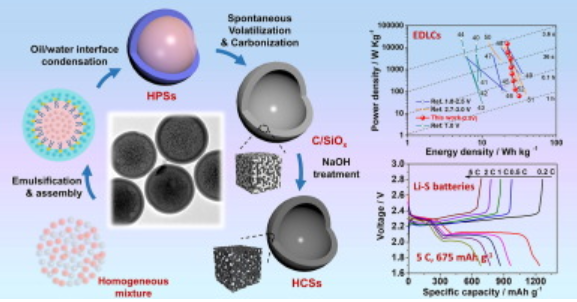Self-propelled nanoemulsion assemblyof organosilane to the synthesis of high-surface-area hollow carbon spheres forenhanced energy storage
MingqiChen, Zhe Su, Yajing Liu, Yankai Pan, Yayun Zhang*, Mengfei Hu, Qingyan Ma, QiZhou, Donghui Long*
Chemical Engineering Journal, 2020, 400, 124973.
文章链接:https://www.sciencedirect.com/science/article/pii/S1385894720309657
Hollow carbon spheres (HCSs) with largeinterior cavity and porous shell have emerged as an important class of carbonmaterials, while exploring novel synthesis methods in terms of convenience,controllability and universality remains a challenge. Herein, we develop aself-propelled nanoemulsion assembly of organosilane approach to fabricate monodispersedHCSs. In this approach, volatile oils are severed as self-elimination softtemplate and organosilane both as carbon precursor and in-situ pore-template.The key to the synthesis is the self-propelled formation of oil-in-waternanoemulsion stabilized by amphipathic hydrolyzed organosilane, which couldhydrolyze at the oil-water interface and condense to form thepolysilsesquioxane shell. The present approach has good controllability anduniversality that can be demonstrated by modulating alternative volatile oils,organosilane precursors and dry condition. After carbonization and NaOHtreatment, the as-prepared HCSs have uniform particle size of ∼900 nm, large cavity, controllable carbon shell of 80–110 nm, and high surface area up to 2300 m2/g. The unique integration of high-surface-area and well-definedhollow spherical morphology make them a great potential as electrode materialsfor supercapacitive energy storage and carbon host for lithium sulfurbatteries. These findings could inspire more novel methodologies forconstructing of high-surface-area yet well-defined nanostructured materials fortackling energy issues.
